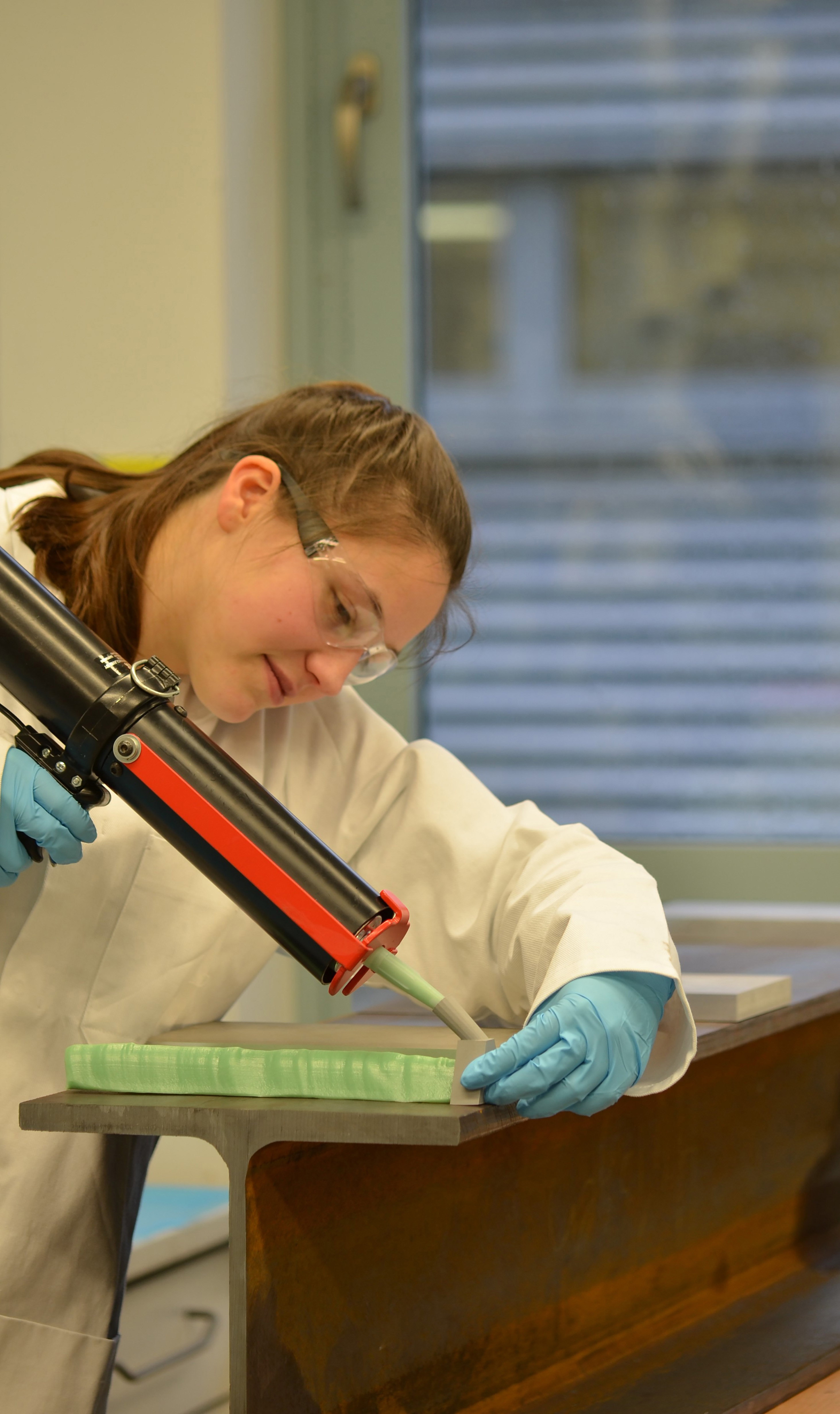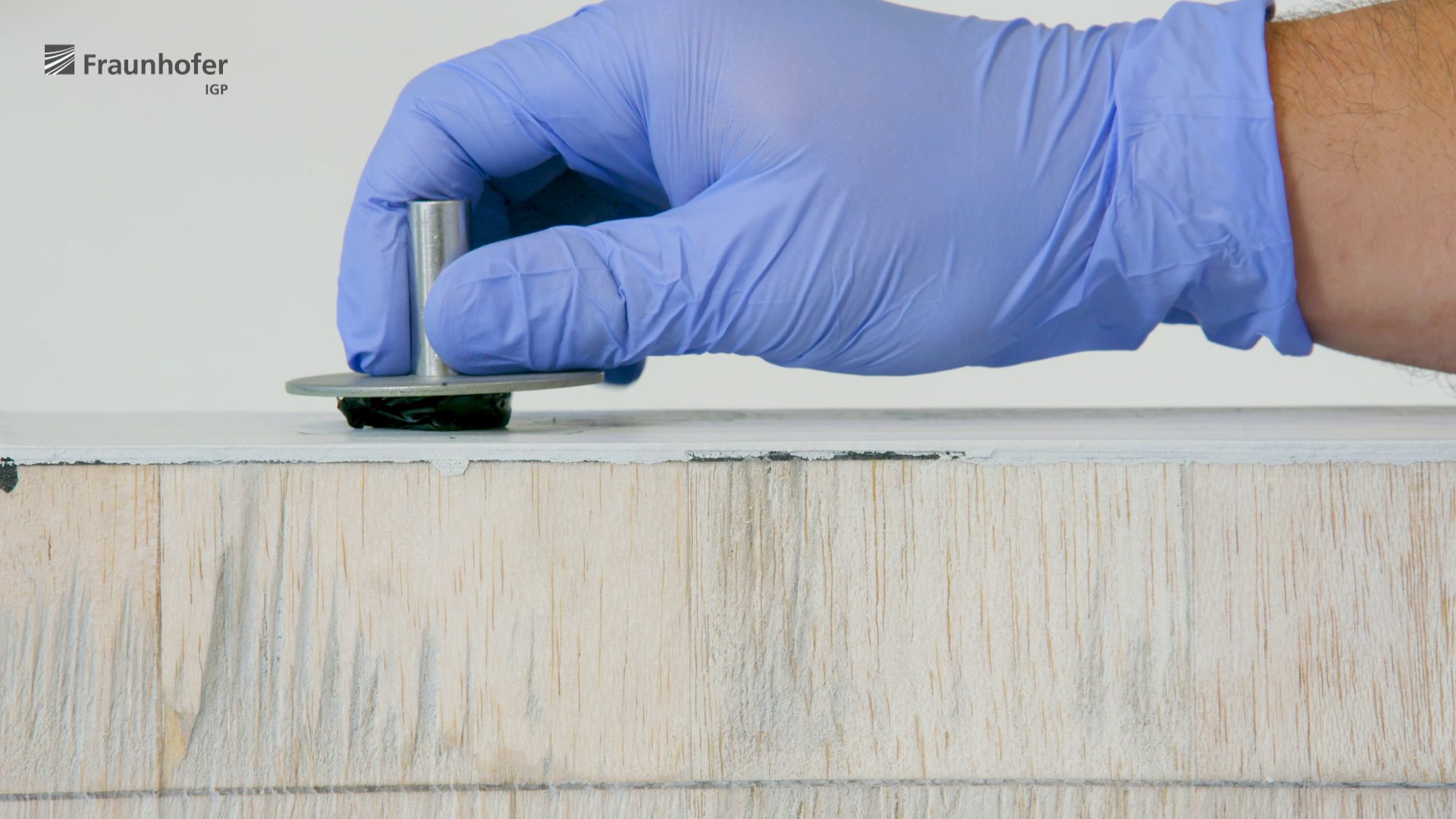Adhesive Bonding Technologies
Field of Work
This area of the Fraunhofer IGP deals with current joining technology problems of lightweight and mixed construction methods as well as with the development and adaptation of manufacturing processes for fibre composite components. Further focal points are the investigation of ageing influences on materials, bonded joints and coatings through laboratory ageing in an artificial climate.

In cooperation with the accredited test laboratory of the Fraunhofer IGP, materials, compounds and coating systems are tested and qualified under standardised conditions. In addition, new test methods are developed and used for special applications.
In the field of adhesive bonding technology, the IGP's range of services extends from the adhesive design of components and assemblies, to the design and dimensioning of bonded joints, to the development and qualification of the entire bonding process as well as the joint.
Project overview adhesive bonding technology
Fibre-reinforced plastic composite bonded joints
Optimisation of fibre plastic composite bonded joints
Durability analysis for bonded joints in large fibre composite plastic joint structures with varying adhesive layer thicknesses
The fatigue behaviour of bonded large structures, such as those found in wind turbine and shipbuilding, is largely determined by manufacturing-related imperfections in the adhesive layer, as these promote the formation and propagation of cracks. The aim of the project is therefore to analyse the influence of these on the service life of large structures made of a fibre-reinforced plastic composite (FRP). To this end, imperfections that occur in practice are first investigated and classified. Selected imperfections are then tested in real and virtual tests by means of static and dynamic tests. From the processing of the results, practice-oriented test methods and design guidelines are derived, whereby the design of FKV bonded joints can be optimised.
Underwater bonding process
Underwater bonding process
Investigation and optimisation of process parameters and tools for underwater bonding of mounting systems
The operation and maintenance of hydraulic structures and vessels often require the subsequent installation of equipment such as sensors, sonar transmitters or corrosion protection equipment under water. Welding processes and mechanical joining result in metallurgical as well as mechanical notches, which is why a bonded holder system was fundamentally developed in the completed IGF project Underwater Bonding (19493 BR). The aim of the current project is to investigate the influence of the process parameters of the multi-stage injection process (media, times, pressures) on the joint quality and to develop a corresponding partially automated tool for use by divers or ROV. The aim is to increase the process reliability, to prove the process limits and to prepare a process for application by ROVs / AUVs.
Adhesive layer ageing
Detect the ageing process of adhesive layers
Demonstration of accelerated laboratory ageing procedures through the identification of parameters relevant to the ageing of bonded joints.
Adhesive bonding technology also offers great advantages as a joining method in shipbuilding and maritime production. Due to the lack of knowledge and regulated test procedures on ageing behaviour, its use is only possible with enormous effort and is thus strongly inhibited. The aim of the research project "Adhesive layer ageing" is to demonstrate accelerated laboratory ageing procedures by identifying the parameters relevant to the ageing of adhesive bonds, with the help of which the durability of adhesive bonds under maritime conditions of use can be proven. The findings and ageing procedures obtained enable SMEs in particular to use adhesive bonds simply and safely in maritime production.
Maritime electromobility
System solution for a maritime city shuttle
VP3: Development and construction of a ship structure
The aim of the E2MUT alliance is to develop and introduce emission-free urban mobility solutions on water. In addition to two collaborative projects dealing with infrastructure and propulsion and energy systems, VP3 deals with the development and construction of the ship's structure, which is adapted to the requirements of alternative propulsion systems through a novel design. In five fields of competence, work is being done, among other things, on the development of a fast urban tug for intra-urban areas as well as on modern inland freighters and electric ferries. The ships pave the way for low-emission passenger and commercial transport thanks to innovative multi-hull hull shapes with adaptive foil support, which are made from fibre composite materials using novel manufacturing and joining processes.
Holder adhesive
Holder bonding in development
The increasing competition in shipbuilding is raising the demands on shipyards and suppliers. There is a demand for ever shorter production times for the entire ship, as well as for the realisation of short-term changes and customer requests in construction phases close to the end. For this reason, a family of holders was developed in the research project (IGF 18527 BG) in addition to a non-destructive method for proving the required minimum load-bearing capacity of the coating. After completion of the project, shipbuilding approval was obtained from two classification societies through further investigations. Currently, the brackets are being further developed to fix hammocks on ships with the help of two combined brackets.
Wind turbines
Checking rotor blades with the help of an autonomous drone
Automatic Rotorblade Groundbased Observation System (Argos)
Underwater adhesive
Adhesive under water
Investigation and optimisation of process parameters and tools for underwater bonding of mounting systems
The operation and maintenance of hydraulic structures and vessels often require the subsequent installation of equipment such as sensors, sonar transmitters or corrosion protection equipment under water. Welding processes and mechanical joining result in metallurgical as well as mechanical notches, which is why a bonded holder system was fundamentally developed in the completed IGF project Underwater Bonding (19493 BR). The aim of the current project is to investigate the influence of the process parameters of the multi-stage injection process (media, times, pressures) on the joint quality and to develop a corresponding partially automated tool for use by divers or ROV. The aim is to increase the process reliability, to prove the process limits and to prepare a process for application by ROVs / AUVs.
Joining process
Adhesive bonding as a joining process
Inspection methods for the periodic testing of highly elastic thick-film and structural adhesives in shipbuilding applications
As a result of increasing lightweight construction requirements, adhesive bonding is gaining in importance as a joining method in shipbuilding. However, the integration of adhesive bonding technology is also hindered by the lack of long-term experience. The aim is to find suitable inspection procedures and intervals for ongoing operations and to expand experience with bonded joints in the maritime sector. In order to achieve this, imperfections in bonded joints typical for shipbuilding are evaluated with regard to their damage potential and influence on service life. Based on the findings, reasonable inspection intervals for the use of bonded joints in shipbuilding will be determined. Furthermore, non-destructive inspection methods for use both in the shipyard and at sea are compiled and tested for their applicability.
Services
- Design and qualification of bonding processes and bonded joints through adhesive selection
- Surface pre-treatment and development of bonding processes
- Development of automation solutions for adhesive bonding applications
- Determination of characteristic values for material and joints by static and cyclic tests as well as polymer analysis
- Analytical and numerical calculation of bonded joints
- Adhesive bonding process execution and component tests under simulated real conditions
 Fraunhofer Institute for Large Structures in Production Engineering IGP
Fraunhofer Institute for Large Structures in Production Engineering IGP